Google’s algorithm updates have focused on the queries to enhancing the user experience from single queries to using conversational language. These conversations are happening on screen devices and more frequently via screen-less devices through voice-driven traffic. Google is trying to improve the searcher experience by surfacing more relevancy into their search results by understanding intent and removing ambiguity on the content they discover – which is clearly seen from their shift from keyword-based SEO to entity-based SEO.
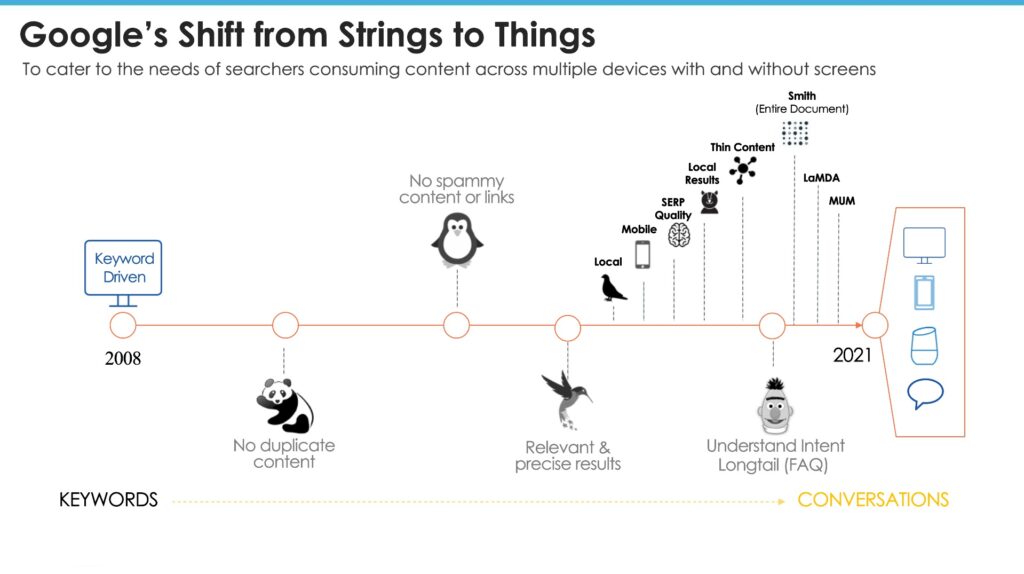
This was particularly because keywords can be limiting when it comes to performing on the search engine results pages. Keywords have two basic characteristics:
- They carry ambiguity.
A keyword can refer to several very different subjects. The keyword “Cookie” can, for example, refers to an edible biscuit or to the information sent by a web server when a page loads.
- A keyword is most of the time specific to a language.
The keyword “machine à laver” in French corresponds to “washing machine” in English or “lavadora” in Spanish.
Moving to an entity-based strategy means more context for search engines, robust content, and better visibility on search for relevant queries.
What is an entity?
In general, Google describes an entity as a single, well-defined thing or concept which can be stored and linked to a knowledge graph. If we think of an entity as a topic, it becomes simpler and helps bring things into perspective where they become well defined by linking related things through structured data. In the example below, we show how Google links the ‘entity’ former US President George Washington on the Knowledge Graph.
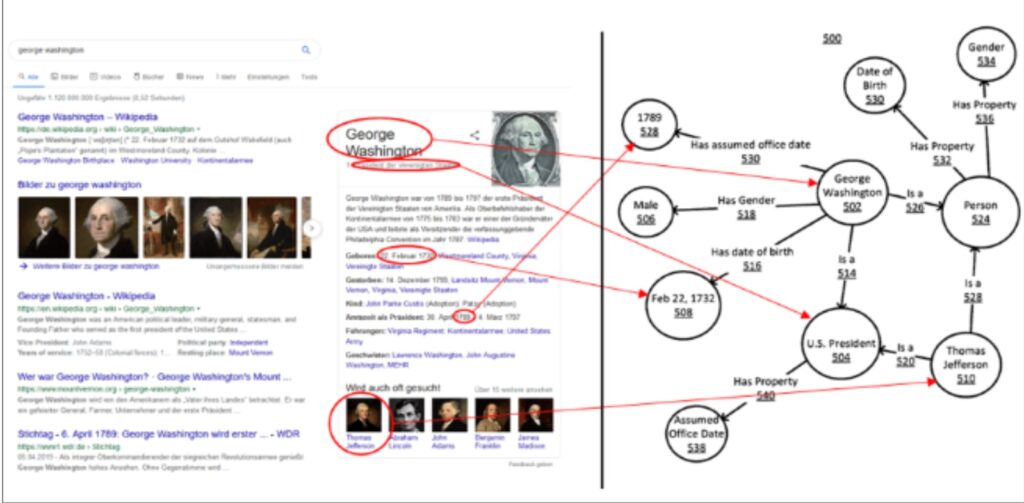
Schemas Strengthen Entities for Better Visibility and Results
From a technical SEO perspective, one of the most effective ways to link entities and create strong connections is through schema markup. As part of our schema strategy, we leverage entities and optimize or maximize SERP visibility for our customers by using schema markup. For example, rich results like FAQs on the page get boosted by schema and the conversational content gets the desired visibility on search. Milestone Research Lab carried out a study to prove this and the results firmly suggested that schema positively impacts visibility and organic performance of website content.

Research Paper: https://go.milestoneinternet.com/schema-research-paper
Google Advises to Strengthen Entities with Structured Data
Google’s John Mueller suggested looking for ways to be more visible to users and using structured data to target a niche audience which will give your website a competitive edge on search.
Source: https://www.seroundtable.com/2021-google-seo-advice-30686.html .
Given that Schema is one of the most effective ways to link and define entities, there are still challenges in adopting schema at scale. Let us look at the main factors contributing to the lack of adoption.
Challenges of Deploying Entity Optimization at Scale
- Google is evolving to cater to searcher intent and need
- Volume of content is changing and growing
- Technical infrastructure is changing
- Schema vocabulary is constantly updated
- Requires constant monitoring and maintenance to ensure schemas are effective by being error-free
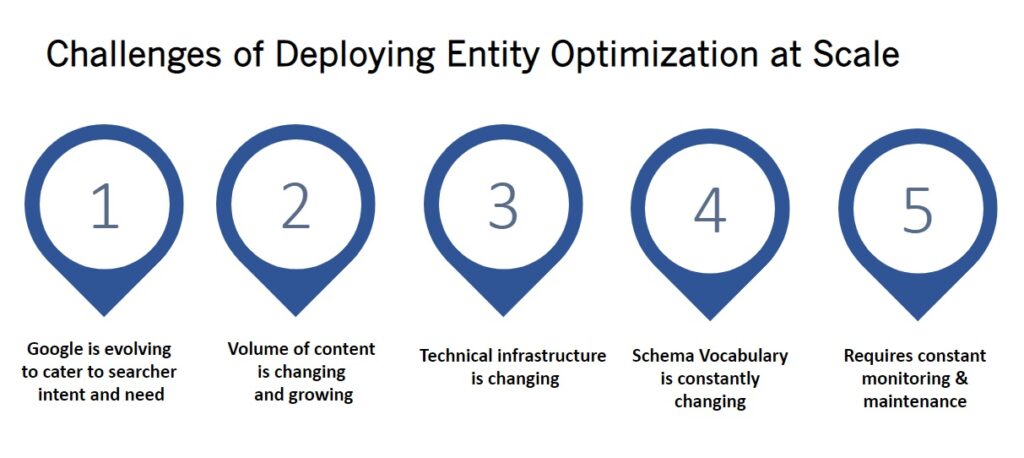
5-Step Entity Optimization Framework for Large Enterprise Sites
Moving from simple tagging into entity optimization requires not only a mind shift but a workflow shift to ensure that the full breadth of content is being created based on the cumulative steps of a searcher journey but that it also includes the correct asset types and reduction of ambiguity through more accurate language and tagging of key entity elements.
To help companies deploy Entity Optimization at scale Milestone has developed the following 5-step framework to enable the rapid and successful deployment of an entity-led optimization program.
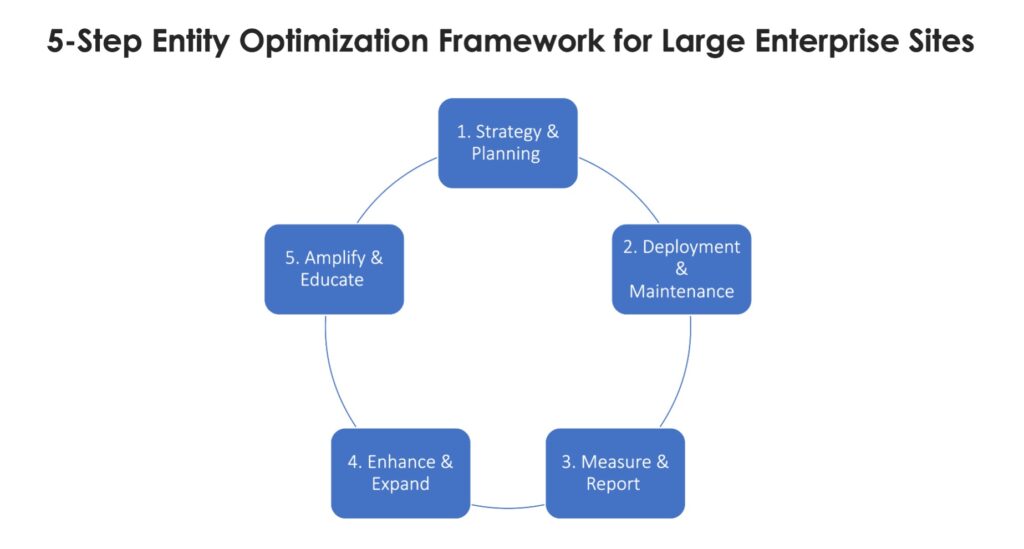
Step 1: Strategy & Planning
It is critical to have a solid strategy and action plan in place that aligns with the business goals of the customer. What sets the Entity Optimization Framework apart is the focus on 3 main pillars of Schema, Content, and Infrastructure.
Step 2: Deployment & Maintenance
Based on the strategy, the program is deployed starting with content discovery, entity mapping based on the industry, and deployment of the updated content and schemas.
Step 3: Measure & Report
As the program is deployed, extensive implementation and performance reporting are leveraged, including the schema performance report, Universal Search Results, Schema Visibility to demonstrate the increased visibility, engagement, and overall business impact.
Step 4: Enhance and Expand
Based on the strategy, depth of deployment, and performance reporting the program is enhanced and expanded to include fresh content and new entities as they are updated by Schema.org. It is an iterative process of adding new content to match the searcher’s journey and discovering new opportunities to interact with searchers.
Step 5: Amplify and Educate
This last step is critical to share the learnings and results far and wide in the organization to ensure wide adoption as well as spur additional ideas and opportunities for even richer content and analysis of the consumer insights that come with connecting with customers.
Success Story: Driving Rich Result Growth using Schemas
For a business that wished to grow its digital presence and focus on its Q&As for its locations, Milestone deployed relevant schemas to give them a boost on search and the results were fascinating.
The Milestone team researched and identified the most suitable schema types for the branch locations, ATMs, banking and lending solutions as well as careers and blog pages. This in turn led to a 61% increase in Impressions and their Rich Results discoverability went up by 95%.
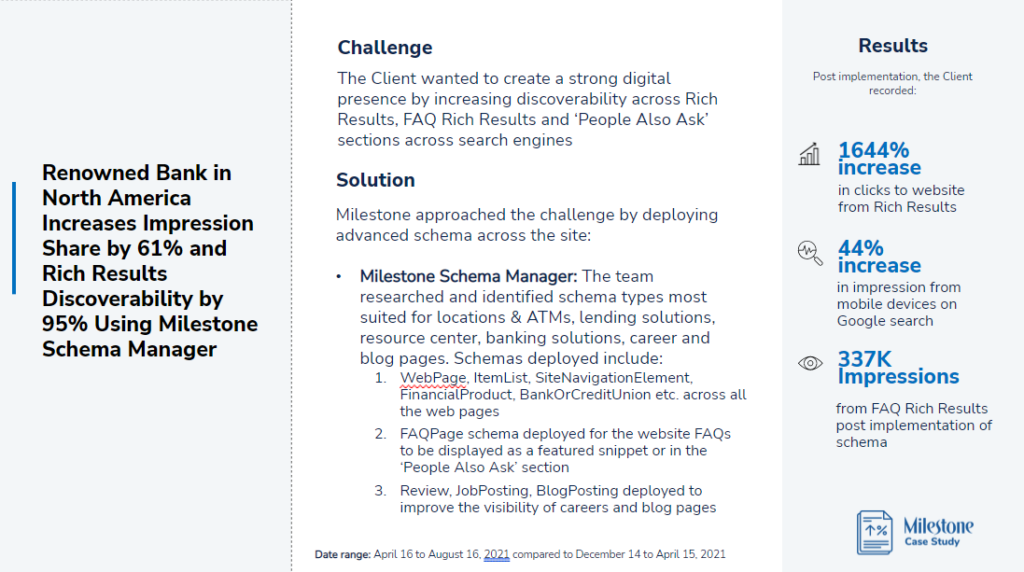
However, these results are not unique, as we have seen similar trends for clients from other verticals as well.
For its schema solution, Milestone Schema Manager has been shortlisted for ‘Most Innovative Product’ at the prestigious US Search Awards 2021.
According to Martechadvisor, “The biggest challenges for content marketers is changes to SEO/search algorithms (61%), closely followed by changes to social media algorithms (45%). The issue is no longer what to produce, but rather how to keep up with the changing search landscape”. With 90% of Digital Content having no digital audience according to an AHREFs study, schemas are your ticket to give your business a competitive edge, and as John Muller rightly stated, it is important to find ways to keep up with the search landscape and trends and stay ahead of your competition.
We at Milestone do an excellent job of keeping up with these accelerating changes and integrating them into our various tools like Schema Manager and FAQ Manager with the focus of moving users from just tagging schemas into a more strategic realm of Entity Optimization.
To get a deeper understanding of the need for entity optimization, to improve your business’s visibility on search and align with the latest search trends, join Milestone’s Founder and President, Benu Aggarwal, along with industry veterans Bill Hunt of Back Azimuth and Dixon Jones of DHJ Ventures at the SMX webinar ‘Why Entity Search Is Your Competitive Advantage’ on November 9th and 10th.
Sources
- https://ahrefs.com/blog/search-traffic-study/
- https://www.martechadvisor.com/articles/content-marketing/why-content-marketing-is-set-to-be-an-industry-worth-41288-billion-by-2021/
Ask our experts
-
Why is entity optimization important?
Entity optimization lets the search engine know about the context of the term that you are optimizing for so that your site can appear for the most relevant searches. Google aims to understand concepts as entities, in other words differentiating between the idea of Polish as a language and polish as something with which to shine a shoe.
Without entity optimizing, it will be more challenging to demonstrate the area in which you are an authority to Google. You want to provide content that builds context for your content so that the search engine can tell precisely what entity you are discussing and the areas specifically where you specialize. Focusing on providing this context as a whole can help your business rank well for the most relevant queries.
-
How do I get started with entity optimization?
To get started with entity optimization, you want to begin by making a list of the entities for which your business should rank. This differs from simply making a list of the keywords you want your site to rank for. You want to instead focus your efforts on the concrete nouns – places, things, ideas– for which you want your site to achieve rankings. Then, define the context in which you specialize.
Then, look at how Google defines this entity and what entities it is connected to. You can uncover this information by looking at what comes up with you typing the entity into Google. See what appears for the Knowledge Graph, what “people also ask” questions come up, and what Google suggests as additional searches.
Finally use the information you have gained and your improved understanding of context and entities to incorporate semantically-related keywords into your content and establish better context and depth for them. Go through your existing content to see how you can better build your context and use LSI keywords to build briefs and outlines that will help you create your upcoming material.
As you build this material, make sure your content has also been appropriately marked up with schema. Mark your entities with schema to ensure that Google understands precisely what topic you are dealing with and can better place your material within its search results.
-
How do I measure entity optimization?
Entity optimization can be measured by looking at a few important KPIs:
- Your site rankings. If your content has been optimized properly, it should appear highly on the SERPs. This in turn should also increase the traffic rates to your website.
- Your on-site engagement. Proper entity optimization indicates that your content gets displayed to people searching for your particular entity, so optimization should increase the relevance of your audience.
- Your appearance in rich results. Marking your content up with schema can help business results appear in rich results for your central entities. Tracking your results can help you see if you begin to attain any of these highly desirable positions.
-
What are entity optimization best practices?
To help your content obtain the entity optimization needed to drive results, you want to practice a few best practices:
- Use schema to clearly articulate the entity you want to optimize for
- See the search results for your entity to better understand what entities Google connects to your targeted entity
- Use LSI keywords to begin to better understand how to give context to the entity you want to optimize your site for
- Focus on optimizing your content as you develop it so that it emphasizes the context of your entity and the particular concept for which you are an expert.


